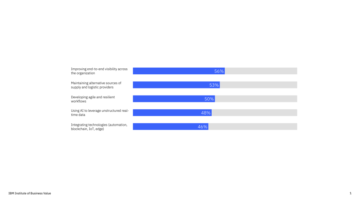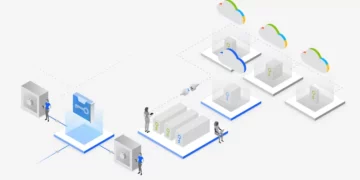
Kubota, a Japanese-based services and technology provider within the agriculture, water and environmental industries, has a keen focus on innovation and sustainability. A few years ago, Kubota aimed to tackle operational efficiency challenges, water and sewage systems maintenance issues, and staff shortages that many local companies faced. Simultaneously, it attempted to commit to its zero carbon city declaration, which aims to virtually eliminate carbon dioxide emissions by 2050. Kubota consulted with IBM® to create a system that uses AI and IoT in the field of operations and maintenance to successfully address Kubota’s business challenges.
The result? IBM deployed IBM® Maximo® Application Suite, which runs on Microsoft Cloud. This deployment aimed to support the development of Kubota Smart Infrastructure System (KSIS) BLUE FRONT, a new system improving the operating efficiency and maintenance of water and wastewater facilities. The comprehensive platform links Kubota’s KSIS, an IoT system, with IBM’s facility maintenance and asset management platform.
By using Microsoft Cloud, the platform can flexibly scale up to accommodate the approximately 100 facilities that Kubota Environmental Engineering Corporation will operate, and handle future increases.
“With KSIS BLUE FRONT, we want to contribute to solving our customers’ problems by centrally managing data on the operation and maintenance of water and wastewater facilities, improving operational efficiency through information visualization, and reducing quality risks and lifecycle costs,” says Junichi Tanabe from Kubota’s Environmental Business Planning and Sales department.
IBM Consulting® helped Kubota to deliver the entire implementation phase and build out the system. Since its deployment, the field has already seen the amount of time spent on administrative work reduced considerably.
Kubota plans to reduce not only the amount of electricity, but also the use of various chemicals and consumables used to operate the plant. This will reduce costs by being more efficient on their data. Kubota is also looking to reduce the budgets of municipalities with water supply facilities by using the IoT data that analyzes breakage, trends and past repairs of their equipment and maintenance.
“It is no exaggeration to say that this initiative has just begun, and with the cooperation of IBM, we hope to develop it into a de facto standard not only in Japan but also globally,” says Tanabe.
Kubota will continue using the dynamic combination of IBM Maximo Application Suite on Microsoft Azure with Red Hat® OpenShift® to support their digital transformation journey. They are working toward the goal of regulating CO2 emissions and achieving carbon neutrality to redefine their approach to the agriculture industry.
For more information on IBM Maximo Suite Application, check out the Microsoft Marketplace. Or to learn more about our partnership with Microsoft and Maximo, check out our “Better Together” blog.
IBM and Microsoft make enterprise-wide transformation a reality
Was this article helpful?
YesNo
More from Sustainability

February 15, 2024
Climate change examples
4 min read – What do global climate change and global warming look like? Surface temperature statistics paint a compelling picture of the changing climate: 2023, according to the European Union climate monitor Copernicus, was the warmest year on record—nearly 1.5 degrees Celsius warmer than pre-industrial levels. To gain a holistic understanding of the current climate crisis and future climate implications, however, it’s important to look beyond global average temperature records. The impacts of climate change may be organized into three categories: Intensifying extreme…

February 14, 2024
The future of renewable energy
5 min read – Renewable energy is energy produced from Earth’s natural resources, those that can be replenished faster than they are consumed. Common examples include solar power, hydropower and wind power. Shifting to these renewable energy sources is key to the fight against climate change. Today, a variety of incentives and subsidies help make it easier for companies to lean on renewable resources as a stable source of power to help alleviate the climate crisis. But the next generation of clean energy requires…

February 13, 2024
4 strategic sourcing use cases to strengthen your supply chain
5 min read – In this age of supply chain disruptions that hold the power to upend entire industries, strength and resilience across the entire value chain is no longer a nice-to-have—it’s a survival tactic. For sourcing teams, that means pivoting their mindset around selecting suppliers from a tactical, lowest-cost-above-all approach to a strategic one. Where tactical sourcing is a short-term strategy, strategic sourcing is for long-term business goals. Sourcing and procurement professionals operating with a strategic sourcing mindset assess a supplier’s quality, reputation…

February 12, 2024
Scaling scope 3 impact and measurement with IBM Envizi Supply Chain Intelligence
< 1 min read – IBM® Envizi™ is pleased to announce the release of additional functionality as we continue to build out our Scope 3 emissions accounting solution. The new Supply Chain Intelligence module, part of the IBM Envizi ESG Suite, captures and aggregates high-volume supplier and product-level transactional data along with product carbon footprint data (PCF) for the purpose of Scope 3 calculation and reporting. Transactional data, including spend, is directly integrated from the client’s ERP system. The emissions calculation engine automates Scope 3 emissions…
IBM Newsletters
Get our newsletters and topic updates that deliver the latest thought leadership and insights on emerging trends.
Subscribe now More newsletters
- SEO Powered Content & PR Distribution. Get Amplified Today.
- PlatoData.Network Vertical Generative Ai. Empower Yourself. Access Here.
- PlatoAiStream. Web3 Intelligence. Knowledge Amplified. Access Here.
- PlatoESG. Carbon, CleanTech, Energy, Environment, Solar, Waste Management. Access Here.
- PlatoHealth. Biotech and Clinical Trials Intelligence. Access Here.
- Source: https://www.ibm.com/blog/how-kubota-is-changing-the-status-quo-in-agriculture-and-sustainability-with-technology/
- :has
- :is
- :not
- :where
- $UP
- 00
- 1
- 100
- 12
- 13
- 14
- 15%
- 2%
- 2023
- 2024
- 2050
- 29
- 30
- 300
- 31
- 39
- 4
- 40
- 400
- 5
- 6
- 65
- 7
- 8
- 9
- a
- About
- above
- accommodate
- According
- Accounting
- achieving
- across
- Additional
- address
- administrative
- Advertising
- against
- age
- aggregates
- ago
- agriculture
- AI
- aimed
- aims
- All
- alleviate
- along
- already
- also
- amount
- amp
- an
- analytics
- analyzes
- and
- Announce
- Application
- approach
- approximately
- ARE
- around
- article
- AS
- assess
- asset
- asset management
- asset management platform
- attempted
- author
- automates
- average
- Azure
- back
- background
- BE
- begun
- being
- Beyond
- Blog
- blogs
- Blue
- Budgets
- build
- business
- Business Planning
- but
- button
- by
- calculation
- CAN
- captures
- carbon
- carbon dioxide
- carbon footprint
- Carbon Neutrality
- card
- Cards
- cases
- CAT
- categories
- Category
- Celsius
- chain
- challenges
- change
- changing
- check
- chemicals
- circles
- CIS
- City
- class
- clean
- clean energy
- client
- Climate
- Climate change
- climate crisis
- Cloud
- color
- combination
- commit
- Common
- Companies
- compelling
- comprehensive
- considerably
- consumed
- Container
- continue
- contribute
- cooperation
- CORPORATION
- Costs
- covered
- cracked
- create
- crisis
- CSS
- Current
- custom
- data
- Date
- de
- declaration
- Default
- definitions
- deliver
- Department
- deployed
- deployment
- description
- develop
- Development
- digital
- Digital Transformation
- directly
- Director
- disruptions
- do
- dynamic
- easier
- ecosystem
- efficiency
- efficient
- electricity
- eliminate
- emerging
- Emissions
- energy
- Engine
- Engineering
- Enter
- Entire
- environmental
- equipment
- ERP
- ESG
- Ether (ETH)
- European
- european union
- examples
- Exit
- faced
- facilities
- Facility
- facto
- false
- faster
- February
- few
- field
- fight
- flexibly
- Focus
- follow
- fonts
- Footprint
- For
- from
- front
- functionality
- future
- Gain
- generation
- generator
- get
- Global
- global warming
- Globally
- goal
- Goals
- Grid
- handle
- harbor
- harvest
- Heading
- height
- help
- helped
- helpful
- hold
- holding
- holistic
- hope
- How
- However
- HTTPS
- Hydropower
- IBM
- ICE
- ICO
- ICON
- image
- Impact
- Impacts
- implementation
- implications
- important
- improving
- in
- Incentives
- include
- Including
- Increases
- index
- industries
- industry
- information
- Infrastructure
- Initiative
- Innovation
- insights
- integrated
- Intelligence
- intensifying
- into
- iot
- issues
- IT
- ITS
- Japan
- journey
- jpg
- just
- Keen
- Key
- large
- latest
- Leadership
- LEARN
- levels
- lifecycle
- like
- links
- local
- locale
- long-term
- longer
- Look
- look like
- looking
- maintenance
- make
- management
- managing
- Managing Director
- many
- max-width
- May..
- means
- measurement
- michelle
- Microsoft
- Microsoft Azure
- min
- Mindset
- minutes
- Mobile
- module
- Monitor
- more
- more efficient
- Municipalities
- Natural
- Navigation
- neutrality
- New
- Newsletters
- next
- no
- nothing
- now
- of
- off
- on
- ONE
- only
- operate
- operating
- operation
- operational
- Operations
- optimized
- or
- Organized
- our
- out
- page
- paint
- part
- Partnership
- past
- phase
- phone
- PHP
- picture
- planning
- plans
- plant
- platform
- plato
- Plato Data Intelligence
- PlatoData
- pleased
- plugin
- policy
- position
- Post
- power
- primary
- problems
- procurement
- Produced
- Product
- Production
- professionals
- provider
- purpose
- quality
- Reading
- records
- Red
- redefine
- reduce
- Reduced
- reducing
- regulating
- release
- Renewable
- renewable energy
- repairs
- Reporting
- resilience
- Resources
- responsive
- result
- risks
- robots
- roof
- runs
- s
- sales
- say
- says
- Scale
- scaling
- scope
- Screen
- scripts
- seen
- selecting
- seo
- Services
- SHIFTING
- short-term
- shortages
- simultaneously
- since
- site
- small
- smart
- snow
- solar
- Solar Power
- solution
- Solving
- Source
- Sources
- Sourcing
- spend
- spent
- Sponsored
- squares
- stable
- Staff
- standard
- start
- statistics
- Status
- Strategic
- Strategy
- strength
- Strengthen
- subscribe
- Successfully
- suite
- sunlight
- supplier
- suppliers
- supply
- supply chain
- support
- Surface
- survival
- Sustainability
- SVG
- system
- Systems
- tackle
- tactical
- teams
- Technology
- tertiary
- than
- thanks
- that
- The
- The Future
- their
- theme
- These
- they
- this
- those
- thought
- thought leadership
- three
- Through
- time
- Title
- to
- today
- top
- topic
- toward
- transactional
- Transformation
- Trends
- Trucks
- type
- understanding
- union
- Updates
- URL
- use
- used
- uses
- using
- value
- variety
- various
- virtually
- visualization
- W
- walking
- want
- Warmer
- was
- Water
- watering
- we
- Wheel
- which
- while
- will
- wind
- wind power
- with
- within
- WordPress
- Work
- worker
- working
- written
- year
- years
- Your
- zephyrnet
- zero












